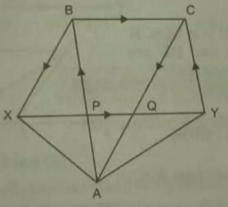In ABC , a line XY parallel to BC cuts AB at X and AC at Y . If BY bisects ∠XYC , then BC=CY (b) BC=BY (c) BC≠CY (d) BC≠BY
Step by step video & image solution for In A B C , a line X Y parallel to B C cuts A B at X and A C at Y . If B Y bisects /_X Y C , then B C=C Y (b) B C=B Y (c) B C!=C Y (d) B C!=B Y by Maths experts to help you in doubts & scoring excellent marks in Class 10 exams.
Topper's Solved these Questions
Similar Questions
Knowledge Check
- Question 1 - Select One
If a+bc+d=xy, then y=_____
Ay=x(a+b)(c+d)By=x(a+b)(c+d)Cy=x(c+d)a+bDy=(a+b)c+d
XY isa line parallel to side BC of ABC.BEA and CFAB meet XY in E and F respectively.Show that ar(ABE)=ar(ACF).
View SolutionABCD is a parallelogram and line segments AX,CY bisect the angles AandC, respectively. Show that AX∣∣CY
View SolutionIn Figure, ABCD is a parallelogram and X and Y are points on the diagonal BD such that DX=BY . Prove that AXCY is a parallelogram (ii) AX=CY, AY=CX AYB ≅CXD (iv) AXD≅ CYB
 View Solution
View SolutionABCD is a trapezium with ABDC. A line parallel to AC intersects AB at X and BC at Y. Prove that ar(ADX)=ar(ACY).
 View Solution
View SolutionThe curves y=aex and y=be−x cut orthogonally, if a=b (b) a=−b (c) ab=1 (d) ab=2
View SolutionIf x=b−c+a,y=c−a+b,z=a−b+c, then prove that (b−a)x+(c−b)y+(a−c)z=0
View SolutionIf the line y=x touches the curve y=x2+bx+c at a point (1, 1) then b=1, c=2 (b) b=−1, c=1 (c) b=2, c=1 (d) b=−2, c=1
View Solution

